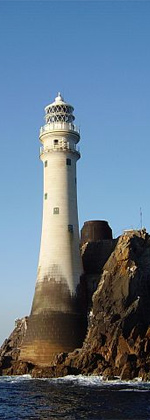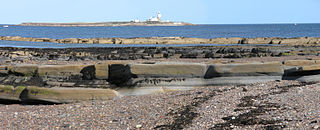
Coquet Island is a small island of about 6 hectares, situated 1.2 kilometres (0.75 mi) off Amble on the Northumberland coast, northeast England. It is included in the civil parish of Hauxley.
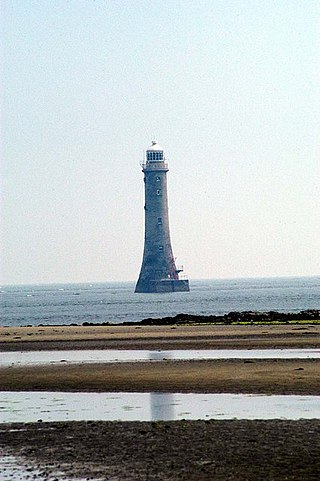
Cranfield Point is the southernmost point of Northern Ireland. It is located at the mouth of Carlingford Lough in the townland of Cranfield, County Down.
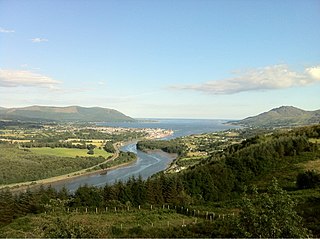
Carlingford Lough is a glacial fjord or sea inlet in northeastern Ireland, forming part of the border between Northern Ireland to the north and the Republic of Ireland to the south. On its northern shore is County Down, the Mourne Mountains, and the town of Warrenpoint; on its southern shore is County Louth, the Cooley Mountains and the village of Carlingford. The Newry River flows into the loch from the northwest.

The Chaine Memorial Tower in Larne, County Antrim, Northern Ireland, is a memorial to James Chaine, a former Member of Parliament for Antrim, who died in 1885. It is a cylindrical stone tower lighthouse with a conical roof, situated on the west side of entrance to Larne Lough.

The SS Connemara was a twin screw steamer, 272 feet long, 35 broad and 14 deep with a gross register tonnage of 1106. She sank on the night of 3 November 1916 at the entrance to Carlingford Lough, Louth, Ireland after being hit amidships by the coalship Retriever. 97 people died that night and the only survivor was James Boyle – a fireman on the Retriever and former caretaker of Warrenpoint Town Hall and a non-swimmer.

Godrevy Lighthouse was built in 1858–1859 on Godrevy Island in St Ives Bay, Cornwall. Standing approximately 300 metres (980 ft) off Godrevy Head, it marks the Stones reef, which has been a hazard to shipping for centuries.

The Hook Lighthouse is a building situated on Hook Head at the tip of the Hook Peninsula in County Wexford, in Ireland. It is one of the oldest lighthouses in the world and the second oldest operating lighthouse in the world, after the Tower of Hercules in Spain. It is operated by the Commissioners of Irish Lights, the Irish lighthouse authority, and marks the eastern entrance to Waterford Harbour. The current structure has stood for over 800 years.

Winterton Lighthouse is located in Winterton-on-Sea in the English county of Norfolk. In 1845 Winterton Ness was described as being 'well known to the mariner as the most fatal headland between Scotland and London'. As well as marking the headland, the lighthouse was intended to help guide vessels into the Cockle Gat, which provided the northern entry into the safe water of Yarmouth Roads. The lighthouse was known to Daniel Defoe and is mentioned in his novel Robinson Crusoe.
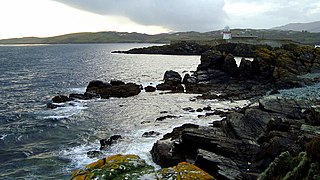
Rotten Island lighthouse is a harbour light to light the passage from St. John's Point to inner channel and past the rocks to the anchorage within Killybegs Harbour, Donegal Bay, Ireland. It is operated by the Commissioners of Irish Lights.
The High lighthouse or pillar lighthouse is one of three lighthouses in Burnham-on-Sea, Somerset, England. A Grade II listed building, it is no longer functional as a lighthouse and has been converted for use as a private dwelling.

Roche's Point Lighthouse is situated at the entrance to Cork Harbour, Ireland. A lighthouse was first established on 4 June 1817 to guide ships into Cork Harbour. The original tower was deemed too small and in 1835 was replaced by the larger present tower which is 49 feet high with a diameter of 12 feet. Roche's Point Lighthouse, and a number of other structures, are located on a headland of the same name.
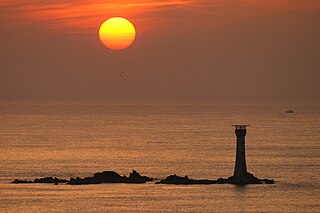
Les Hanois Lighthouse was constructed between 1860 and 1862 to a design by James Walker, and was first lit on 8 December 1862. It is sited on the rock known as Le Biseau, or Le Bisé, part of the reef Les Hanois one mile north west of Pleinmont where the Trinity House cottages were built. It was erected in response to an increasing number of shipwrecks on the treacherous rocks off the western coast of Guernsey.

The Maidens lighthouses, on the Maidens in North Channel off County Antrim in Northern Ireland, date from 1829 and were built at the request of merchants and a Royal Navy officer. Lighthouses were built on both rocks; the West Maiden was abandoned in 1903 and the East Maiden was automated in 1977.

Casquets Lighthouse is an active lighthouse located on the rocky Les Casquets, Alderney, Channel Islands.

Plover Scar Lighthouse, also known as the Abbey Lighthouse, is an active 19th century lighthouse sited at the entrance of the Lune estuary, near Cockersand Abbey in Lancashire, England. The lighthouse is maintained by the Lancaster Port Commission. It is registered under the international Admiralty number A4876 and has the NGA identifier of 114-5144.

Blackhead Lighthouse is a listed lighthouse built at the turn of the 20th century, near Whitehead in County Antrim, Northern Ireland. It marks the very northern end of Belfast Lough where it opens out into the North Channel that separates Northern Ireland and Scotland. The active lighthouse is managed by the Commissioners of Irish Lights, where it is named as the Blackhead Antrim Lighthouse to distinguish it from the more modern Blackhead lighthouse in County Clare.

The Inisheer, Inis Oírr or Fardurris Point Lighthouse, is an active 19th century lighthouse located on the island of Inisheer, the smallest of the Aran Islands, in County Galway, Ireland. It marks the south-eastern entrance to Galway bay and the port of Galway known as the South Sound, with a red sector of the light marking the Finnis Rock. The Eeragh Lighthouse which marks the North Sound entrance to the bay on the north-western side of the islands, was also constructed at the same time. Inisheer and Eeragh both became operational in 1857.

Eeragh Lighthouse is an active lighthouse located on Rock Island, one of the Brannock Islands, part of the Aran Islands archipelago in County Galway, Ireland. It marks the north-western entrance to Galway Bay and the port of Galway known as the North Sound. Due to its location it is also known as the Aran North Lighthouse. The lighthouse on Inisheer at the south-eastern end of the islands was also constructed at the same time. Eeragh and Inisheer both became operational in 1857.
The Foyle, Carlingford and Irish Lights Commission (FCILC) is a commission supervised by the North/South Ministerial Council with responsibility for two agencies which span the Irish border, namely the Loughs Agency and the Lights Agency. The FCIC is one of the implementation bodies established in 1999 under the 1998 British–Irish Agreement during the Northern Ireland peace process.
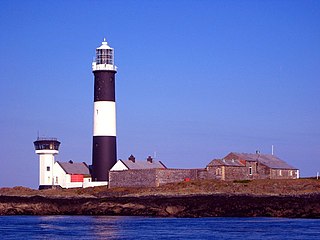
Mew Island Lighthouse is an active lighthouse within the Copeland Islands of County Down in Northern Ireland. The current 19th-century tower is the most recent in a series of lighthouses that have been built in the islands, which have helped to guide shipping around the archipelago and into Belfast Lough.




















